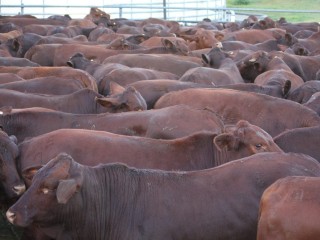 The Australian cattle market’s benchmark price indicator has surrendered 8.75c/kg for the week, reflecting increases in saleyards numbers, mixed quality yardings with the onset of winter and concerns about flat terms of trade in export markets.
The Australian cattle market’s benchmark price indicator has surrendered 8.75c/kg for the week, reflecting increases in saleyards numbers, mixed quality yardings with the onset of winter and concerns about flat terms of trade in export markets.
The Eastern Cattle Young Indicator closed yesterday at 387.5c/kg, having retraced since Monday all of the gradual increases recorded over the previous two weeks.
Yardings across NLRS reported sales from Monday to Thursday totalled 16,922 head, a rise of 4417 head on last week.
Yesterday’s Roma prime sale bucked the national trend, with rates defying a small increase in supply to improve across most classes.
The 1870 head yarding was dominated by heavy steers, bullocks and cows, which totalled 1348
head. The large panel of buyers attracted by the heavier cattle pushed heavy steer and bullock prices 6c dearer and cows 7c dearer.
At Dubbo agents yarded 2500 head, 710 more than the previous week, with quality reported as plainer. Vealer steers held firm, vealer heifers lost up to 10c/kg depending on breed, while heavier cattle lost from 6 to 10c depending on the category. The NLRS said the draft included “extra older” steers with some carrying plenty of weight.
At Bairnsale in Victoria yesterday numbers were down by 10pc to 602 head. The NLRS said that despite one regular export processor not being present, demand was mostly firm to better. Vealers were in demand to sell 5-10c dearer, while other cattle were quoted as generally firm to cheaper.
A small increase of 129 cattle at Colac to 681 in a mixed quality yarding yesterday saw prices down by 10c/kg on average.
While supplies and quality are affecting the market at saleyard level, at the other end processors are reporting extremely flat trading conditions in the major markets of US and Japan.
Beef Central reported yesterday that product destined for the export market is now coming back onto the domestic market.
Chairman of the Australian Meat Industry Council, Queensland processor Terry Nolan, said the high A$ and lacklustre export markets were to blame for the current diversion of product onto the local trade.
“It’s a double-whammy because the domestic trade is flat at the moment due to cost of living pressures. That will only make it harder to find outlets for the additional beef than it would otherwise normally be,” Mr Nolan said. Click here to see the article.
The National Livestock Reporting Services uses the Eastern Young Cattle Indicator (EYCI) as the general benchmark of Australian cattle prices. It is a seven-day rolling average produced daily by the NLRS.
It includes vealer and yearling heifers and steers, grade score C2 or C3, 200kg+ liveweight from saleyards in NSW, QLD and VIC. The results include cattle purchased for slaughter, restocking or lotfeeding and are expressed in cents per kilogram carcase (dressed) weight (c/kg cwt).
